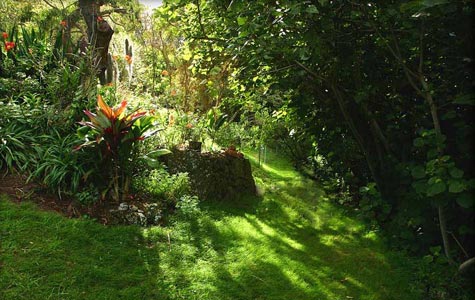Research – Mapping Project & Arboretum Inventory
| Fleming Arboretum entrance | The 8 acre Fleming Arboretum – view from cabin |
|---|---|
 |
 |
| Bob Bangerter photo | Dona Lock photo |
Fleming Arboretum Mapping Project by Robert Hobdy
BACKGROUND
Visionary agriculturalist, David T. Fleming, having witnessed the steady decline of Maui’s native forests, perceived the need for an arboretum that would protect and preserve native species. In 1952 he created such an arboretum, that would come to be known as the Fleming Arboretum, situated at Pu’u Mahoe in the Ulupalakua Area of East-Maui. Fleming would focus his attention on the mesic and dry forest species found in the Kanaio and Kahikinui areas on the south slope of Haleakala. As these native forests have continued to decline and individual species have become rare or disappeared, the value of Flemings arboretum collection has become recognized. The families continuing expansion and professional management of this resource continues to this day. As the importance of the Fleming Arboretum has increased, the family has realized the need for improved mapping and record keeping of their resources.
In December, 2004 a request for grant funding was submitted to the Fred Baldwin Memorial Fund to help finance these improvements. On March 16, 2005 the grant was approved and a contract for the project was secured. The principle elements of the goals and work are outline below.
MAPPING
– Create an accurate map of the layout of the Fleming Arboretum
– Show the location of all plants under cultivation
– Identify all the species and species groupings under cultivation
DATABASE
– Create a coding system, coordinated with the map, identifying each plant
– Record the most up to date taxanomic nomenclature for each plant
– Record the common or Hawaiian name for each plant
– Record the status for each plant by region
– Record the distributional status for each plant within Hawaii by island
– Record the current federal status of endangerment for each plant
– Record the origin of each plant
– Record the date each plant was planted
– Present the above system in an electronic form from which links can be created for
recording detailed cultural and maintenance records for each plant.
REPLACEMENT PROTOCOL
Arboretums are dynamic by nature. New accessions are frequently made, plants grow and mature, and periodically plants die. Accessions must receive a new location code when planted in a new spot in the Arboretum. In such cases the new coding number should, where possible, fit into the established spatial sequencing. Sometimes this is not possible, unless fractional numbers are used, and code numbers may become out of sequence. Sometimes accessions are placed in a spot where a plant has died. In such cases the accession can take over the vacated code number. In order to reestablish the orderly sequencing arrangement this system needs to be overhauled and renumbered every 10 years or so as circumstances dictate.
Thanks to the Arboretum Inventory Jan 2006 by Robert Hobdy, funded by the Fred Baldwin Memorial Foundation, there is now a count of total:
245 plants, 92 Species, (19 “Endangered”, 4 “Species of Concern” and 3 “Candidates”).
